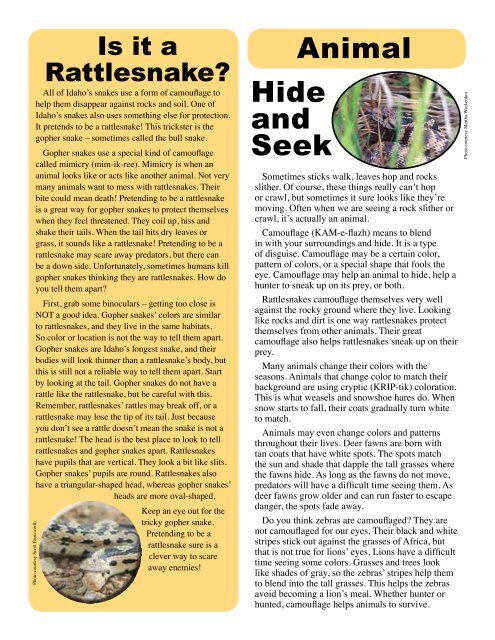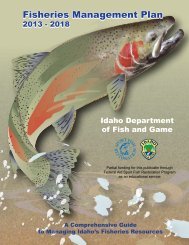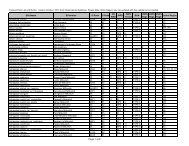May 2010 - Idaho Fish and Game
May 2010 - Idaho Fish and Game
May 2010 - Idaho Fish and Game
Create successful ePaper yourself
Turn your PDF publications into a flip-book with our unique Google optimized e-Paper software.
Photo courtesy Scott Farnsworth<br />
Is it a<br />
Rattlesnake?<br />
All of <strong>Idaho</strong>’s snakes use a form of camouflage to<br />
help them disappear against rocks <strong>and</strong> soil. One of<br />
<strong>Idaho</strong>’s snakes also uses something else for protection.<br />
It pretends to be a rattlesnake! This trickster is the<br />
gopher snake – sometimes called the bull snake.<br />
Gopher snakes use a special kind of camouflage<br />
called mimicry (mim-ik-ree). Mimicry is when an<br />
animal looks like or acts like another animal. Not very<br />
many animals want to mess with rattlesnakes. Their<br />
bite could mean death! Pretending to be a rattlesnake<br />
is a great way for gopher snakes to protect themselves<br />
when they feel threatened. They coil up, hiss <strong>and</strong><br />
shake their tails. When the tail hits dry leaves or<br />
grass, it sounds like a rattlesnake! Pretending to be a<br />
rattlesnake may scare away predators, but there can<br />
be a down side. Unfortunately, sometimes humans kill<br />
gopher snakes thinking they are rattlesnakes. How do<br />
you tell them apart?<br />
First, grab some binoculars – getting too close is<br />
NOT a good idea. Gopher snakes’ colors are similar<br />
to rattlesnakes, <strong>and</strong> they live in the same habitats.<br />
So color or location is not the way to tell them apart.<br />
Gopher snakes are <strong>Idaho</strong>’s longest snake, <strong>and</strong> their<br />
bodies will look thinner than a rattlesnake’s body, but<br />
this is still not a reliable way to tell them apart. Start<br />
by looking at the tail. Gopher snakes do not have a<br />
rattle like the rattlesnake, but be careful with this.<br />
Remember, rattlesnakes’ rattles may break off, or a<br />
rattlesnake may lose the tip of its tail. Just because<br />
you don’t see a rattle doesn’t mean the snake is not a<br />
rattlesnake! The head is the best place to look to tell<br />
rattlesnakes <strong>and</strong> gopher snakes apart. Rattlesnakes<br />
have pupils that are vertical. They look a bit like slits.<br />
Gopher snakes’ pupils are round. Rattlesnakes also<br />
have a triangular-shaped head, whereas gopher snakes’<br />
heads are more oval-shaped.<br />
Keep an eye out for the<br />
tricky gopher snake.<br />
Pretending to be a<br />
rattlesnake sure is a<br />
clever way to scare<br />
away enemies!<br />
Hide<br />
<strong>and</strong><br />
Seek<br />
Animal<br />
Sometimes sticks walk, leaves hop <strong>and</strong> rocks<br />
slither. Of course, these things really can’t hop<br />
or crawl, but sometimes it sure looks like they’re<br />
moving. Often when we are seeing a rock slither or<br />
crawl, it’s actually an animal.<br />
Camouflage (KAM-e-flazh) means to blend<br />
in with your surroundings <strong>and</strong> hide. It is a type<br />
of disguise. Camouflage may be a certain color,<br />
pattern of colors, or a special shape that fools the<br />
eye. Camouflage may help an animal to hide, help a<br />
hunter to sneak up on its prey, or both.<br />
Rattlesnakes camouflage themselves very well<br />
against the rocky ground where they live. Looking<br />
like rocks <strong>and</strong> dirt is one way rattlesnakes protect<br />
themselves from other animals. Their great<br />
camouflage also helps rattlesnakes sneak up on their<br />
prey.<br />
Many animals change their colors with the<br />
seasons. Animals that change color to match their<br />
background are using cryptic (KRIP-tik) coloration.<br />
This is what weasels <strong>and</strong> snowshoe hares do. When<br />
snow starts to fall, their coats gradually turn white<br />
to match.<br />
Animals may even change colors <strong>and</strong> patterns<br />
throughout their lives. Deer fawns are born with<br />
tan coats that have white spots. The spots match<br />
the sun <strong>and</strong> shade that dapple the tall grasses where<br />
the fawns hide. As long as the fawns do not move,<br />
predators will have a difficult time seeing them. As<br />
deer fawns grow older <strong>and</strong> can run faster to escape<br />
danger, the spots fade away.<br />
Do you think zebras are camouflaged? They are<br />
not camouflaged for our eyes. Their black <strong>and</strong> white<br />
stripes stick out against the grasses of Africa, but<br />
that is not true for lions’ eyes. Lions have a difficult<br />
time seeing some colors. Grasses <strong>and</strong> trees look<br />
like shades of gray, so the zebras’ stripes help them<br />
to blend into the tall grasses. This helps the zebras<br />
avoid becoming a lion’s meal. Whether hunter or<br />
hunted, camouflage helps animals to survive.<br />
Photo courtesy Martha Wackenhut













